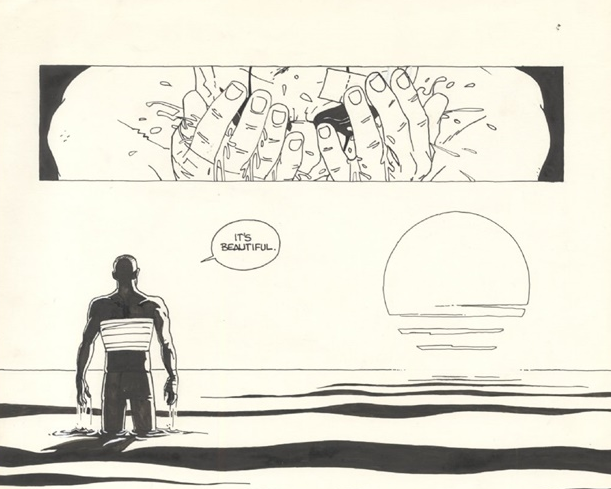 Written by Kaare Andrews
Written by Kaare AndrewsIllustrated by Kaare Andrews and Jose Villarrubia
Marvel
There's always a lot of borrowing between DC and Marvel. Marvel had What if? and DC did Elseworlds. DC did an Invasion and Marvel did one, too, albeit 2 decades later. They both revamped their standby heroes left and right in the 90s.
So I really don't mean any offense when I say that this book is Marvel's answer to The Dark Knight Returns. To try and pretend otherwise is silly. (One of the first characters we see is called Miller Jansen for God's sake.) This is a book about a world where superheroes are banned from New York, Peter has retired from being a costumed vigilante, and the government is slowly taking freedom away from the populace.
In addition, old villains show up again, like Electro, Sandman, and the Scorpion, seemingly stronger than the wall crawler. And there's even J. Jonah Jameson playing the role of Commissioner Gordon, crying out for what has been lost. (Though this is ironic because of the hatred he always showed for Spider-Man.) About all we're missing is a Spider-Girl for a sidekick.
At first blush, then, this book is fairly derivative. However, there is a big difference, and that's in the nature of the focal character. Batman is driven by his obsession to prevent the crime that changed his life, and so is Spider-Man. But how they do about satisfying that obsession is entirely different, and that's what makes Reign a great read, despite the similarities in plot.
Reign begins with a broken Peter Parker looking very much like an old version of the weakling introduced by Lee and Ditko. He sees that the world has gone to hell, but despite remembering what happened the last time he failed to act, prefers to stay in the shadows. But of all people, Jameson won't let him stay buried.
Soon, as Peter battles personal demons in a nice touch, he also battles the forces of oppression as New York's only superhero. Jameson eggs him on, but there's only one problem. The old villains are back, too--and they're backed by the government. Only one thing can save him, in a twist that's perfectly fitting with the characters involved. I won't spoil it because it's a perfect moment and a real treat for long-time Spider-Man fans.
Given new purpose, Peter starts to take control of things while Jameson does what any good reporter does--gets the facts. They end up coming to the same conclusion while Andrews sets up some of the keys to the story. Peter is now ready to accept perhaps the ultimate responsibility--death in exchange for setting his city free.
Can he do it? Is there enough in the old man's tank (this Spider-Man is presumably 60 or so) to face his deadliest foes one last time? And even if he can, is it too late to thwart one more evil scheme? Jameson can only watch as his old nemesis--the man he hated for so very long--is the very man who can set him free.
Throughout most of the story, Andrews shows a man who is very much in conflict. Peter is ready to give up, but "the mask" won't let him. He talks about seeing things from a distance as he is born again. It takes a radical shift in his outlook to realize that Spider-Man is who he is and always will be. Once that change happens, Andrews shifts him into the man we knew, but with a slightly darker edge to match the new times around him.
As with any Spider-Man story, the supporting cast is extremely important. Jameson is shown as fiery as ever, his anger turned towards foes far more dangerous than capes. It would have been nice to see anyone else from the old guard, but the youngsters inspired to fight by Peter's example and Sandman's ever-conflicted villainy make up for the difference. The evil mayor is pretty much a cardboard figure, but that's okay when so many of the others are vibrant and cast perfectly.
Artistically, Andrews is a bit of a mixed bag. His faces are strong but the figures tend to fly out there without a lot of sense of proportion. It's a very loose style that shows off Spider-Man's flexibility but will not play well for you if you're a strict fan of realism. This is not the proportional accuracy of a Romita or the wild exaggeration of a Larsen. It's an odd formation where proportion is relative to the idea Andrews wants to show on the page, changing as needed, sometimes from panel to panel. I like it here because the whole idea of the story is fanciful, but I'm not sure I'd want a steady dose of that design style.
Overall, Reign is wonderful tribute to the idea of a character who can inspire hope by showing that the common man, even if he is a bit more powered than most, can still triumph through sheer willpower against a seemingly unstoppable force. While Batman strikes fear and inspires from dark caves, Spider-Man saves the day in broad daylight. Andrews' homage to Frank Miller is a fitting way to show that no matter the circumstances, Spider-Man will never give up, no matter how hard he might want to. That's a lesson we can all learn from.







